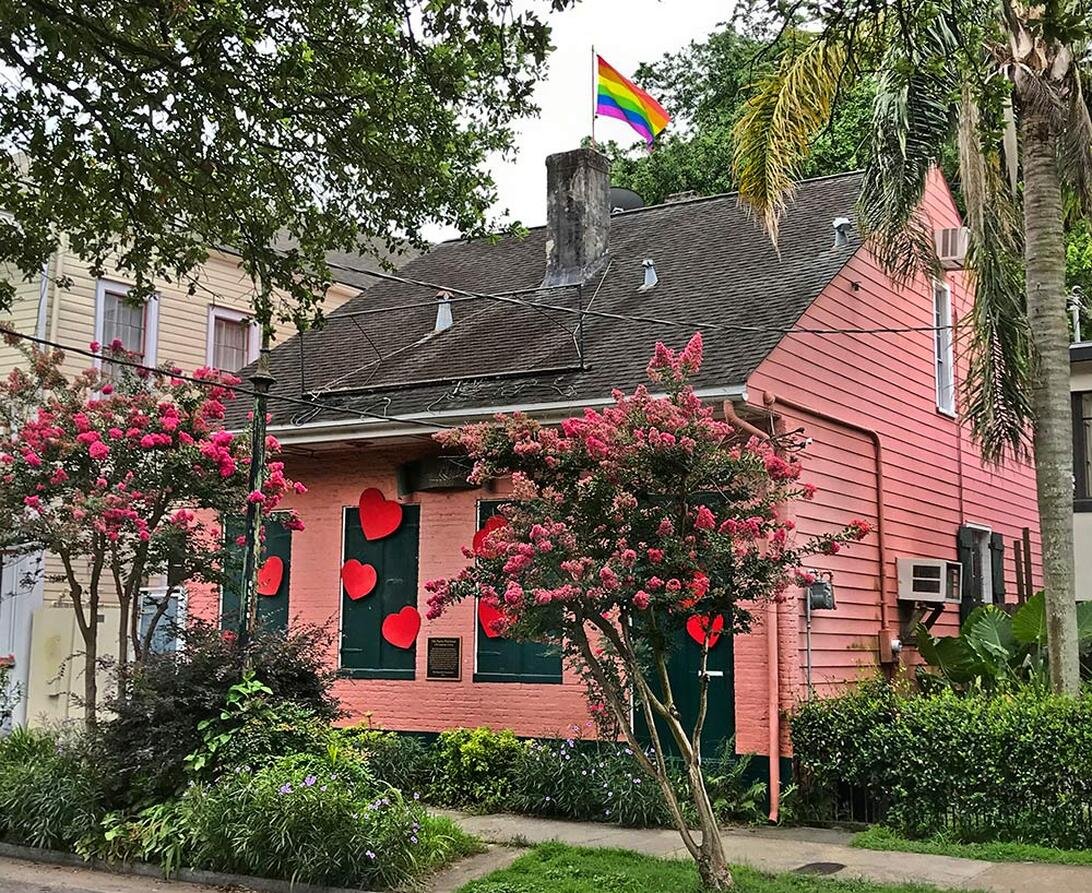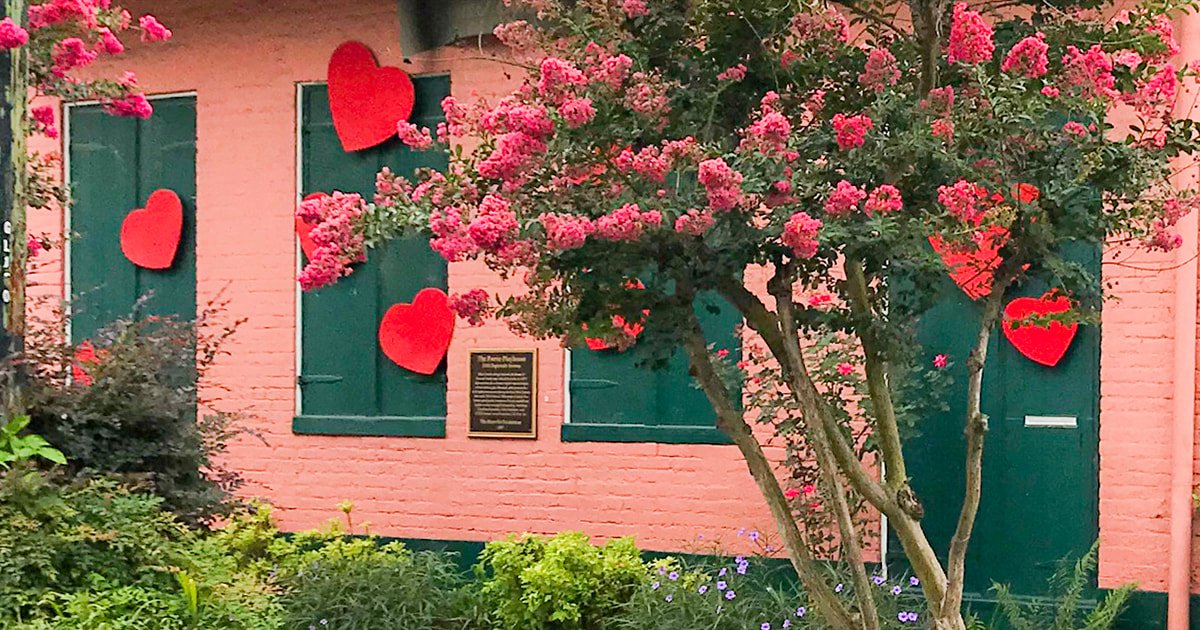The Faerie Playhouse on Esplanade
May 2024A historic Creole Cottage on Esplanade Avenue became both a gathering place and resting place for gay rights activists – and now a nationally recognized cultural LGBTQ site.
– by Frank Perez
photographs by Ellis Anderson Many are familiar with the red Creole Cottage adorned with hearts at 1308 Esplanade Avenue, but most are unfamiliar with the home’s fascinating history, specifically, its centrality in local queer history.
The Esplanade property was originally part of the Plauche Plantation and the cottage itself dates to 1844. It’s the only remaining one of four identical structures called the Passebon Row cottages. The home’s first owner was Athalie Drouillard, a free woman of color. Since then, the home has had numerous owners. Two of the most interesting were a gay couple, Stewart Butler and Alfred Doolittle.
Alfred Dolittle and Stewart Butler
Butler and Doolittle met during Mardi Gras weekend in 1973 and fell immediately in love. A few months later, they were at the Up Stairs Lounge, a gay bar on the edge of the Quarter, the night an arsonist set fire to it, leaving the bar just minutes before the fire was set.
The trauma of having survived the fire cemented Butler’s commitment to the gay liberation movement, then just emerging in New Orleans. A few years later, Butler and Doolittle attended the Anita Bryant protest in Jackson Square in 1977. That protest rally and march was the first large demonstration on behalf of LGBT+ rights in Louisiana.
The following year, Doolittle, who had grown up in a very wealthy San Francisco family, inherited his family’s fortune and told Butler to retire and become a full-time gay rights activist. Butler did just that and in 1979, the two purchased the home that would eventually come to be known as The Faerie Playhouse.
The Faerie Playhouse in 1978, before Butler and Dolittle bought it. The Historic New Orleans Collection, 1978.2.99 i,ii
Over four decades, The Faerie Playhouse would become the center of an amazing array of lives. It would become the gathering place for an ever-evolving group of friends called “The Family.” Much of New Orleans LGBT+ activism of the late 20th and early 21st centuries would take place there.
Stewart Butler, courtesy THNOC oral history project. The Historic New Orleans Collection, gift of Stewart P. Butler, MSS 628.3
At various times, it would also be a farm of sorts (plantains, cotton, avocados, sugar cane, peppers, and potatoes), an orchard (kumquats, limes, grapes, and pears), a youth refuge, a guest house, a wildlife refuge (squirrels, rats, mice, geckos, turtles, and several cats and dogs), a memorial garden (hosting the cremains of nearly two dozen people), a bird refuge (sparrows, cardinals, blue jays, pigeons, hummingbirds, crows, and bumble bees), a meeting house, a winery, a spa, an art gallery, and a wedding chapel. But most of all, it was the home of Stewart Butler and Alfred Doolittle.
Butler’s wall of hats
The Faerie Playhouse derives its name from a play performed there. On Saturday, June 20, 1992, a few dozen people – mostly gay men – gathered in the early evening in the backyard for the “world premiere” (and only production) of Peter Puck, an original play written by Alfred Doolittle. The smell of marijuana was strong and almost everyone in attendance, including the actors, was very, very high.
The performance was in honor of Doolittle’s 56th birthday. Doolittle, who billed himself “Alfred the Elf, Friend and Counselor to the Elves,” wrote and directed the play and reveled in the fact his friends had joined him in realizing his creative talents. The actors included Lenny Frank, Karl Ezkovich, Rich Magill, and John Foster, with Stewart as the narrator.
Peter Puck was a comedy in one act that featured the son of a conservative Rabbi who falls in love with the daughter of their next-door neighbor, a liberal professor of Greek classics. At one point, Professor Doolittle tells his daughter, “Don’t have anything to do with that mama’s boy next door. He’s probably as religious as his father, the Rabbi.” For his part, the Rabbi gives his son Peter a similar warning, “You’ll end up like that sex fiend next door.” But the two children do meet and, not unpredictably, get married.
Although Peter Puck would not win any theatrical awards, its premiere at The Faerie Playhouse embodied the essence of what can only be described as a magical love story—the love story of Stewart and Alfred, soulmates whose relationship not only spanned a pivotal era in the history of queer New Orleans, but also helped shape it. When Peter Puck premiered, Stewart and Alfred had been together nineteen years, thirteen of which played out at The Faerie Playhouse.
In Butler’s years as a full-time activist, he co-founded or worked closely with a staggering array of local queer advocacy groups, including the Louisiana Lesbian and Gay Political Action Caucus, New Orleans Parents and Friends of Lesbians and Gays, the New Orleans LGBT Community Center, and the LGBT+ Archives Project of Louisiana.
A hidden wall in an alcove holds recognitions of Butler’s achievements in activism
In 2007, a plaque was placed on the front of the Faerie Playhouse and states the home:
“… was the site of many organizing meetings in the LGBT civil rights movement during the late 20th Century and early 21st Century. The garden behind the home contains the cremains of many significant leaders in the struggle for equality, including Charlene Schneider, John Ognibene, and Cliff Howard, as well as artist J.B. Harter.”
Since 2007, others have been added to the Memorial Garden, bringing the total now to twenty-one. The garden also includes the remains of four pets.
Otis Fennell is the most recent activist to have his ashes find a home at the Faerie Playhouse. Read about Otis here.
Otis Fennel’s April Celebration of Life at the Faerie Playhouse. See more photos here.
The Memorial Garden has its origins with a troubled young man named Pierre “Peter” DeLancey. In 1989, Frances Monnier, a man from Raceland, Louisiana, who occasionally made the 45-minute or so trip to New Orleans to attend PFLAG meetings, connected Stewart to DeLancey.
DeLancey was seventeen years old, gay, dyslexic, epileptic, and alcoholic. Stewart’s first impression of DeLancey was that he was “a total mess.” Indeed, he was. Abused by his father routinely since age five, DeLancey ran away from home when he was fourteen and was placed in the Lafourche Parish Juvenile Justice Facility when he was fifteen. There, a guard sexually assaulted him regularly.
Rich Magill described his life as “sad and tragic … He had little education and was illiterate … he never held a job … and he never had a home of his own.” He worked periodically as a fisherman and factory worker and even appeared in a few pornographic films, but on the whole, stability eluded him. Nonetheless, he did manage to find some joy in living and maintained a remarkably positive attitude, expressing a desire to help homeless youth.
After being released from juvenile detention in 1987, he eventually found his way to New Orleans and took temporary shelter at the Covenant House, a residential facility for homeless youth. Although not legally, Stewart and Alfred “adopted” DeLancey and gave him a home at The Faerie Playhouse. DeLancey lived with Stewart and Alfred on and off for ten years. During that time, DeLancey bonded with Butler and Doolittle’s dog, a Cocker Spaniel named Adonai.
DeLancey was HIV positive and when the disease began progressing and he knew the end was near, he reached out to Stewart and Alfred and asked if he could come home to The Faerie Playhouse to die. They said yes, of course, and upon arriving, DeLancey expressed his desire to be cremated and have his ashes buried in the backyard. He also asked that Adonai be buried with him when Adonai passed.
Both DeLancey and Adonai died in 1998. The request was honored and thus the origins of the Memorial Garden. Also in the garden are the partial remains of Doolittle, who died in 2008, and Butler, who died in 2020.
Recently, the National Park Service selected the Faerie Playhouse as the inaugural site to launch a series of 3-D virtual tours of significant queer sites around the country. Take the virtual tour here. You can also access this NPS podcast with myself as Butler’s biographer.
Before he died, Butler left the Faerie Playhouse to St. Anna’s Episcopal Church with the condition that his caretaker, Bill Hagler, could live there as long as he wanted. Butler’s friends and family are currently in the process of exploring the possibility of purchasing the home from the church. For more information on that effort, visit https://www.faerieplayhouse.org/
Faerie Playhouse caretaker Bill Hagler
An altar dedicated to Stewart Butler
Your donations make stories like this one possible:

















